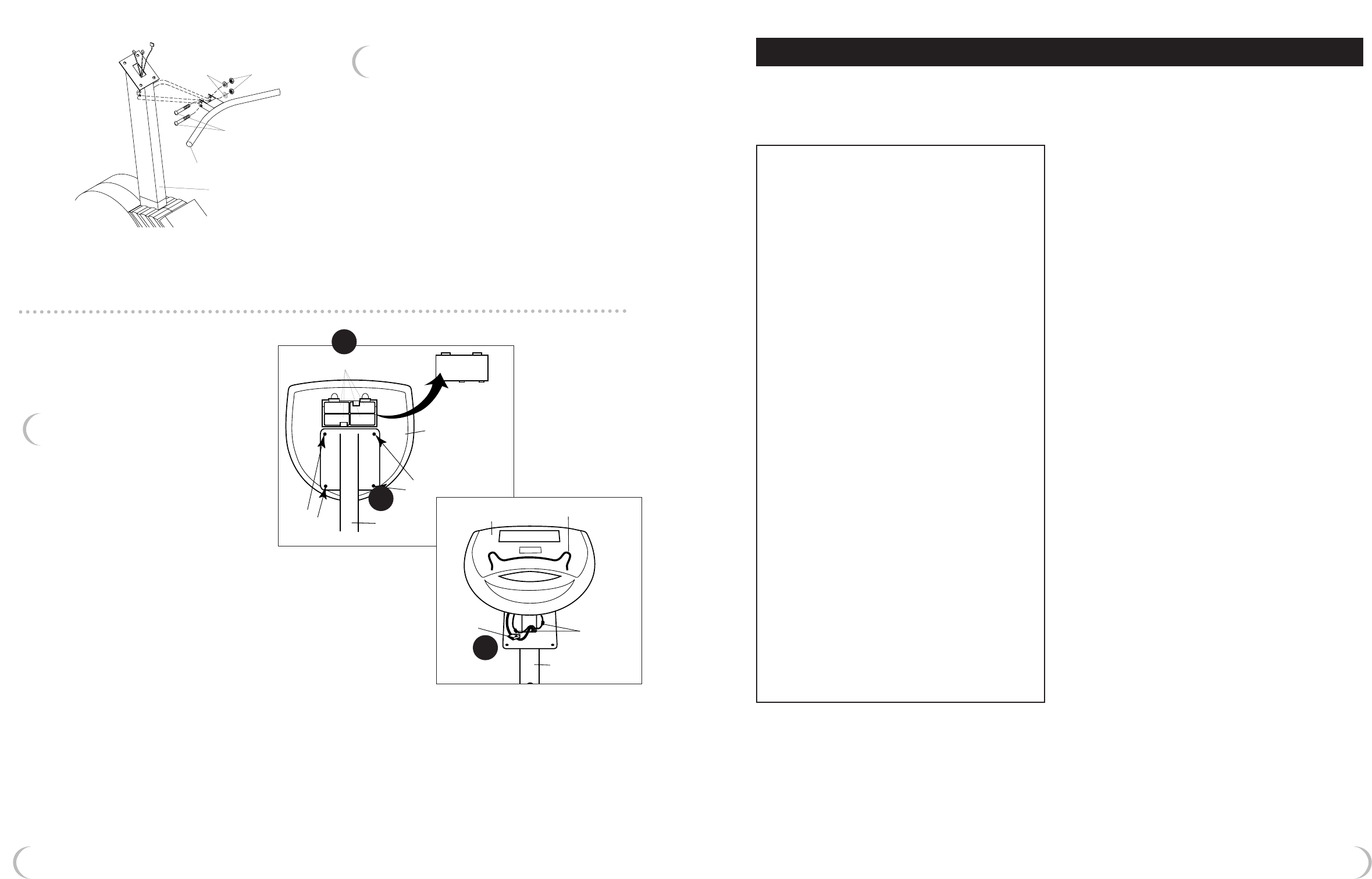
1910
STEP 9 – Computer Installation
a) Remove battery door from back of
Computer, insert (4) “C” batteries
and replace the battery door.
Note: DO NOT use rechargeable
batteries, doing so will cause a
short and destroy the computer.
b) Remove (4) Phillips Bolts from back
of Computer.
c) Connect Computer Wires and Computer Tube Wires
together and carefully tuck wires into Computer
Tube, see Figure 9c.
d) Mount Computer to Computer Tube using the
(4) Phillips Bolts removed in Step 9b and tighten.
e) Book Holder can be attached to the front of the
Computer at any time.
4
1
3
2
four "C" batteries
back of
computer
phillips bolts
phillips
bolts
computer
tube
battery
door
Back
View
9b
9a
STEP 8 – Front Handlebar
Installation
a) Remove (2) Allen Bolts, (2) Washers and
(2) Nylon Nuts from Front Handlebar.
b) Align bolt holes in Front Handlebar with
holes in Computer Tube, see Figure 8.
c) Re-install (2) Allen Bolts, (2) Washers and
(2) Nylon Nuts that were removed in step
8a and tighten.
M8 nylon nuts
M8 washers
front handlebar
M8 x 60mm
allen bolts
computer tube
Figure 8 - Install Front Handlebar
Figure 9 - Install Computer
book holder
computer
wire
computer
tube wire
computer
tube
computer
Front
View
9c
IMPORTANT
Please review this section before you begin exercising.
EXERCISE GUIDELINES
IMPORTANT:
If you are over 35 and have been inactive
for several years, you should consult your
physician, who may or may not recommend
a graded exercise test.
If you are just beginning your exercise program,
your target heart rate range should be roughly at
60% of your maximum heart rate. As you become
more conditioned (or if you are already in good
cardiovascular shape) you can increase your
target heart rate to 70%-85% of your maximum
heart rate. Remember, your target heart rate is
only a guide.
You should also consult your physician if you
have the following:
• High blood pressure
• High cholesterol
• Asthma
• Heart trouble
•Family history of early stroke or
heart attack deaths
• Frequent dizzy spells
• Extreme breathlessness after mild exertion
• Arthritis or other bone problems
• Severe muscular, ligament or
tendon problems
• Other known or suspected disease
• If you experience any pain or tightness
in your chest, an irregular heartbeat or
shortness of breath, stop exercising
immediately. Consult your physician
before continuing.
•Pregnant
• Balance Impairment
•Taking medications that affect heart rate
KNOWING THE BASICS
Physical fitness is most easily understood by
examining its components, or "parts".
There is widespread agreement that these
five components comprise the basics of
physical training:
CARDIORESPIRATORY ENDURANCE – the ability
to deliver oxygen and nutrients to tissues, and to
remove wastes, over sustained periods of time.
Using your bike will improve this.
MUSCULAR STRENGTH – the ability of a muscle to
exert force for a brief period of time. Upper-body
strength, for example, can be measured by various
weight-lifting exercises.
MUSCULAR ENDURANCE – the ability of a muscle,
or a group of muscles, to sustain repeated
contractions or to continue applying force against
a fixed object. Push-ups are often used to test
endurance of arm and shoulder muscles.
FLEXIBILITY – the ability to move joints and use
muscles through their full range of motion. The sit-
and-reach test is a good measure of flexibility of
the lower back and backs of the upper legs.
BODY COMPOSITION – often considered a
component of fitness. It refers to the makeup of the
body in terms of lean mass (muscle, bone, vital
tissue and organs) and fat mass. An optimal ratio of
fat to lean mass is an indication of fitness, and the
right types of exercises will help you decrease body
fat and increase or maintain muscle mass. To help
track your progress we have provided Workout
Progress Charts on pages 26 and 27.
A COMPLETE EXERCISE PROGRAM
How often, how long and how hard you exercise,
and what kinds of exercises you do should be
determined by what you are trying to accomplish.
Your goals, your present fitness level, age, health,
skills, interest and convenience are among the
factors you should consider. For example, an
athlete training for high-level competition would
follow a different program than a person whose
goals are good health and the ability to meet
work and recreational needs.
Your exercise program should include something
from each of the four basic fitness components
(continued on next page)

















